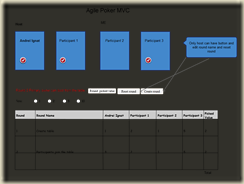This is the part 3 of 5 of my implementing of a MVC Browser history
MVC browser history – idea
Browser history –2 – implementing, small bugs
Browser history 3–trying to Nuget – modifications in order to can be transformed from an application to a component
Browser history 4–NuGet again – finally Nuget deployment
Browser history–part 5–conclusions – conclusions
TL;DR : Trying to add a feature (NuGET ) will conduce you to other features – apparently easy to implement – but took 2 hours…
Content:
First, source control is more important – http://www.joelonsoftware.com/articles/fog0000000043.html .I choose github – deploy is a breeze with GitHub for windows . More, appharbor integration with github is awesome – you can see the application live at http://browserhistory.apphb.com/ .
Now , for generating Nuget package, I should be moving the classes on their own assembly / dll. Also , added this blog to the info. Ensure it works the same. Uploaded to GitHub

And appharbor just deployed

Now, it will be good if I let user switch implementation between memory saving and database saving… in order to developers( that have installed the dll with NuGet ) switch easily to their database.
Created
BrowserUserHistoryRepositorySqlServer
and , after some implementing of IBrowserUserHistoryRepository , the method
public IBrowserUserHistoryRepository FilterByUser(string UserName)
put some problems – but solved with a private variable.
Now must decide the best way to switch between MemoryRepository and SqlServerRepository in
public static T AddOrRetrieveFromApplication<T>(HttpApplicationStateBase app)
where T:new()
First, we must retrieve at runtime the instance of the interface – so structuremap to the rescure.
Second, if we need to retrieve a class – must have at least a default constructor.
So the constraint of the T was gone away – and the code is
T result;
if (typeof(T).IsInterface) {
result =(T) ObjectFactory.GetInstance(type) ;
}
else
{
result = (T)Activator.CreateInstance(type);
}
Also, in global.asax the following lines were added:
//ObjectFactory.Configure(ce => ce.For<IBrowserUserHistoryRepository>().Use<BrowserUserHistoryRepositoryMemory>()); //uncomment those for sql server ce ObjectFactory.Configure(ce => ce.For<IBrowserUserHistoryRepository>().Use<BrowserUserHistoryRepositorySqlServer>());
Now, when deploy , AppHarbor will NOT found EntityFramework dll.
Added HintPath to csproj to find EF
<HintPath>..\packages\EntityFramework.5.0.0\lib\net40\EntityFramework.dll</HintPath>
as seen at
http://blog.appharbor.com/2012/04/24/automatic-migrations-with-entity-framework-4-3
and it works!
More, it works with sql server AppHarbor addon and transformation of web.config.

It took 2 hours to do this thing, apparently simple.

Now you can find the code source on github at https://github.com/ignatandrei/MVCbrowserHistory
You can browse the application at http://browserhistory.apphb.com/
Next time: (maybe some tests and ) NuGET!










![clip_image001[4] clip_image001[4]](http://msprogrammer.serviciipeweb.ro/wp-content/uploads/MVC-4_94F/clip_image0014.jpg)
![clip_image002[4] clip_image002[4]](http://msprogrammer.serviciipeweb.ro/wp-content/uploads/MVC-4_94F/clip_image0024.jpg)
![clip_image003[4] clip_image003[4]](http://msprogrammer.serviciipeweb.ro/wp-content/uploads/MVC-4_94F/clip_image0034.jpg)
![clip_image004[4] clip_image004[4]](http://msprogrammer.serviciipeweb.ro/wp-content/uploads/MVC-4_94F/clip_image0044.jpg)
![clip_image005[4] clip_image005[4]](http://msprogrammer.serviciipeweb.ro/wp-content/uploads/MVC-4_94F/clip_image0054.jpg)
![clip_image006[4] clip_image006[4]](http://msprogrammer.serviciipeweb.ro/wp-content/uploads/MVC-4_94F/clip_image0064.jpg)
![clip_image007[4] clip_image007[4]](http://msprogrammer.serviciipeweb.ro/wp-content/uploads/MVC-4_94F/clip_image0074.jpg)
![clip_image008[4] clip_image008[4]](http://msprogrammer.serviciipeweb.ro/wp-content/uploads/MVC-4_94F/clip_image0084.jpg)
![clip_image009[4] clip_image009[4]](http://msprogrammer.serviciipeweb.ro/wp-content/uploads/MVC-4_94F/clip_image0094.jpg)
![clip_image010[4] clip_image010[4]](http://msprogrammer.serviciipeweb.ro/wp-content/uploads/MVC-4_94F/clip_image0104.jpg)
![clip_image012[4] clip_image012[4]](http://msprogrammer.serviciipeweb.ro/wp-content/uploads/MVC-4_94F/clip_image0124.jpg)
![clip_image013[4] clip_image013[4]](http://msprogrammer.serviciipeweb.ro/wp-content/uploads/MVC-4_94F/clip_image0134.jpg)
![clip_image014[4] clip_image014[4]](http://msprogrammer.serviciipeweb.ro/wp-content/uploads/MVC-4_94F/clip_image0144.jpg)
![clip_image015[4] clip_image015[4]](http://msprogrammer.serviciipeweb.ro/wp-content/uploads/MVC-4_94F/clip_image0154.jpg)
![clip_image016[4] clip_image016[4]](http://msprogrammer.serviciipeweb.ro/wp-content/uploads/MVC-4_94F/clip_image0164.jpg)
![clip_image017[4] clip_image017[4]](http://msprogrammer.serviciipeweb.ro/wp-content/uploads/MVC-4_94F/clip_image0174.jpg)
![clip_image018[4] clip_image018[4]](http://msprogrammer.serviciipeweb.ro/wp-content/uploads/MVC-4_94F/clip_image0184.jpg)
![clip_image019[4] clip_image019[4]](http://msprogrammer.serviciipeweb.ro/wp-content/uploads/MVC-4_94F/clip_image0194.jpg)
![clip_image020[4] clip_image020[4]](http://msprogrammer.serviciipeweb.ro/wp-content/uploads/MVC-4_94F/clip_image0204.jpg)
![clip_image021[4] clip_image021[4]](http://msprogrammer.serviciipeweb.ro/wp-content/uploads/MVC-4_94F/clip_image0214.jpg)
![clip_image022[4] clip_image022[4]](http://msprogrammer.serviciipeweb.ro/wp-content/uploads/MVC-4_94F/clip_image0224.jpg)
![clip_image023[4] clip_image023[4]](http://msprogrammer.serviciipeweb.ro/wp-content/uploads/MVC-4_94F/clip_image0234.jpg)
![clip_image024[4] clip_image024[4]](http://msprogrammer.serviciipeweb.ro/wp-content/uploads/MVC-4_94F/clip_image0244.jpg)
![clip_image025[4] clip_image025[4]](http://msprogrammer.serviciipeweb.ro/wp-content/uploads/MVC-4_94F/clip_image0254.jpg)